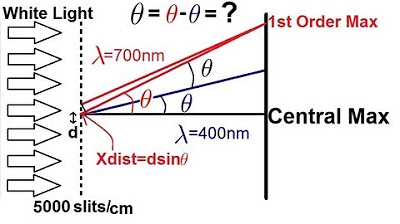Red Green and Blue - RGB | Physics with Professor Matt Anderson | M28-07
TLDRThis script delves into the fascinating subject of color perception, explaining how we identify colors through learned associations. It highlights the subjectivity of color, noting the absence of definitive wavelengths for colors like red, green, or blue. The visible spectrum is discussed, ranging from 400 to 700 nanometers, with ROYGBIV representing the sequence of colors from long to short wavelengths. The script also connects this understanding to technology, explaining how RGB (red, green, blue) in computer monitors creates a myriad of colors through the combination of these primary colors.
Takeaways
- 🎨 Color Perception: The script discusses how we perceive different colors through our eyes and how they are taught to us by our environment.
- 📚 Color Naming: It emphasizes that color names are subjective and learned, with no definitive wavelength for each color.
- 🌈 Visible Spectrum: The visible light spectrum is explained, ranging from approximately 400 to 700 nanometers, with different colors associated with different ranges.
- 🔬 Color Wavelengths: The script describes the wavelength ranges for red, green, and blue, highlighting that reds are longer wavelengths and blues are shorter.
- 🌠 ROYGBIV: The acronym ROYGBIV is mentioned to represent the order of colors in a rainbow, from red to violet, correlating with increasing frequency and decreasing wavelength.
- 🖥️ RGB in Technology: The reason for choosing red, green, and blue (RGB) in computer monitors and other digital displays is explained, as these are the primary colors used to create a wide range of colors.
- 🔍 Subdivision of Colors: The script touches on the idea that colors are not absolute but have ranges, and that intermediate shades are subjective and can have various names.
- 🤔 Subjectivity of Color: It is pointed out that the perception of color is subjective and can vary from person to person.
- 🌌 Mixing Colors: The concept of mixing colors to create new shades and the resulting subjectivity in naming these mixed colors is discussed.
- 👀 Observing Colors: The script suggests that our observation of colors is influenced by how we have been taught to identify and name them.
- 📱 Digital Displays: It is mentioned that if one were to zoom in on a computer monitor or smartphone screen, they would see the RGB dots that make up the images.
Q & A
What is the main topic discussed in the script?
-The main topic discussed in the script is the concept of color, how we perceive it, and the technical aspects of color representation in the visible spectrum and digital displays.
Why do we associate specific names with colors like red, green, and blue?
-We associate specific names with colors due to cultural and educational influences. As we grow up, we are taught to recognize and name colors based on societal conventions.
What does the term 'subjective' imply in the context of color?
-In the context of color, 'subjective' implies that the perception and naming of colors can vary among individuals and cultures, and there is no definitive wavelength for each color.
What is the visible spectrum's range in nanometers?
-The visible spectrum ranges from about 400 nanometers to about 700 nanometers.
What colors are associated with the lower and higher ends of the visible spectrum?
-Blues are associated with the lower end of the spectrum, around 400 to 500 nanometers, while reds are at the higher end, around 600 to 700 nanometers.
What is the acronym 'ROYGBIV' and what does it represent?
-ROYGBIV is a mnemonic representing the colors of the rainbow in order: Red, Orange, Yellow, Green, Blue, Indigo, and Violet. It helps to remember the sequence of colors in the visible spectrum.
Why are red, green, and blue specifically chosen for computer monitors?
-Red, green, and blue are chosen for computer monitors because these colors can be combined in various ways to produce a wide range of other colors, and they correspond to the primary colors used in digital displays.
What does RGB stand for and what is its significance in digital imaging?
-RGB stands for Red, Green, and Blue. It is significant in digital imaging as these are the primary colors used to create all other colors on a computer screen or smartphone display.
How are colors displayed on a computer monitor or smartphone?
-Colors are displayed on a computer monitor or smartphone through the combination of red, green, and blue dots or bars, which when viewed from a distance, blend together to form the full spectrum of colors.
What is the significance of the phrase 'mixing colors' in the context of the script?
-In the context of the script, 'mixing colors' refers to the process of combining different colors to create new shades and hues, which can lead to a more nuanced and subjective understanding of color.
How does the script suggest we observe and understand color?
-The script suggests that we observe and understand color through our experiences and education, as well as through the technical aspects of how colors are displayed and represented in the digital world.
Outlines
🌈 Understanding Color Perception
The first paragraph delves into the concept of color, starting with basic colors like pink, green, and blue. It discusses the subjective nature of color perception, influenced by cultural and educational factors. The speaker explains that there is no single wavelength that defines a color, but rather a range within the visible spectrum from approximately 400 to 700 nanometers. They introduce the ROYGBIV mnemonic to represent the sequence of colors in the rainbow, with red having the longest wavelength and violet the shortest. The paragraph concludes with an explanation of why red, green, and blue (RGB) are significant, as they are the primary colors used in computer monitors and other digital displays, made up of tiny red, green, and blue dots that combine to create a wide array of colors when viewed from a distance.
Mindmap
Keywords
💡Color
💡Wavelength
💡Visible Spectrum
💡Subjectivity
💡ROYGBIV
💡RGB
💡Perception
💡Shades
💡Spectrum
💡Observation
💡Mixing Colors
Highlights
Color perception is subjective and varies based on cultural and personal experiences.
Color names are taught by parents and teachers, but there is no definitive wavelength for each color.
The visible spectrum ranges from 400 to 700 nanometers, with different colors representing different ranges within this spectrum.
ROYGBIV represents the sequence of colors in a rainbow, with red being the longest wavelength and violet the shortest.
Red wavelengths range from 600 to 700 nanometers, while blue wavelengths are between 400 to 500 nanometers.
The concept of mixing primary colors to create a wide range of secondary and tertiary colors.
The significance of the RGB (Red, Green, Blue) color model in digital displays.
Computer monitors and smartphones use red, green, and blue dots to create a full spectrum of colors.
Zooming into a digital display reveals bars of red, green, and blue that combine to create the colors we see.
The importance of understanding color theory for digital design and art.
The human eye perceives color through the observation of light wavelengths.
Cultural differences can influence the way colors are named and perceived.
The visible spectrum is a continuous range, not discrete color points.
The concept of color is tied to human perception and naming conventions.
The practical application of color theory in technology, such as in computer graphics and displays.
The role of subjective interpretation in the naming and understanding of color shades.
The educational aspect of learning color names and their corresponding wavelengths.
The scientific explanation of how different wavelengths of light are associated with different colors.
The idea that color perception is a learned process rather than an innate ability.
The technical composition of a computer monitor, highlighting the RGB model's role in color representation.
Transcripts
5.0 / 5 (0 votes)
Thanks for rating:





